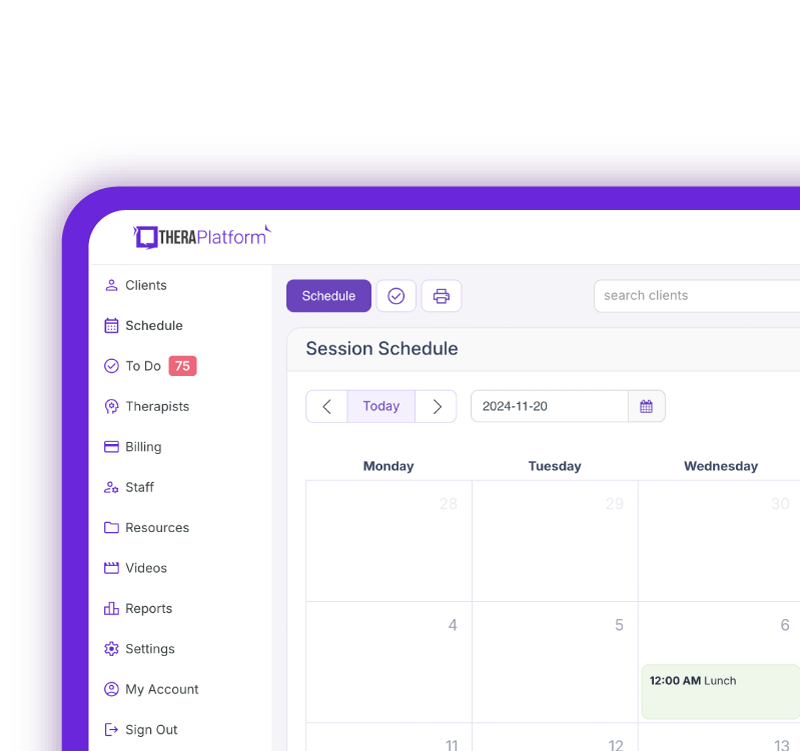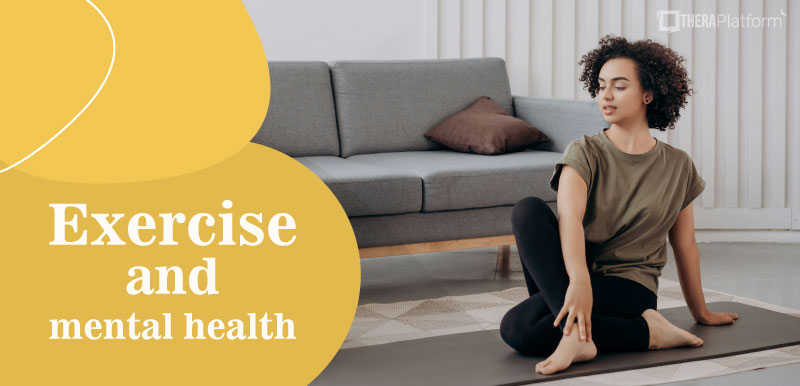Visualization techniques for anxiety

Visualization can be utilized in many different ways. Here are some of the most popular types of visualization techniques for anxiety.
Summary
- Visualization is a powerful tool for reducing anxiety and can be used in various forms such as relaxation, rumination control, and performance enhancement.
- Techniques like imagining a peaceful scene, a “happy place,” or using the “blue sky” method help clients manage intrusive thoughts and ground themselves in the present.
- Visualization can be personalized and combined with CBT to reframe negative thoughts, build compassion, and improve coping responses. Download my free CBT worksheets.
- Guided visualizations, body scans, and progressive muscle relaxation can be tailored to individual needs, making them versatile tools in therapy for anxiety management.
- By leveraging an EHR like TheraPlatform, therapists can organize treatment exercises and homework.
Streamline your practice with One EHR
- Scheduling
- Flexible notes
- Template library
- Billing & payments
- Insurance claims
- Client portal
- Telehealth
- E-fax

Relaxation
The most common type of visualization is part of a relaxation exercise to reduce anxiety. After all, you can't be anxious and relaxed simultaneously. Visualization is usually a key component of relaxation training, along with techniques such as deep breathing, meditation, and muscle relaxation.
Rumination buster
Not only can visualization techniques for anxiety be employed as a tool to calm someone, but clients can use them to gain control of intrusive thoughts. Instead of ruminating, a person may picture those thoughts as fleeting objects or those that can be momentarily ignored. For example, one technique asks individuals to imagine intrusive thoughts as objects carried downstream on a river while their body is anchored safely near the shore.
Performance
Visualization techniques for anxiety enhance performance that has declined. This is frequently associated with taking tests. By applying visualization to distract, relax, and be positive, the test taker can focus on doing their best rather than being overrun by worries.
Practice Management + EHR + Telehealth
Mange more in less time in your practice with TheraPlatform

.
Outcome visualization
A related form of visualization is outcome visualization, which occurs when people picture themselves successfully performing a behavior to increase performance. For example, a baseball player in a hitting slump may picture themselves taking the positive steps to eventually hit a home run. Or, a test taker may imagine themselves remaining calm and taking an exam. Despite its name, outcome visualization focuses on the process and the outcome, breaking down the task into parts that eventually form a successful whole.
Compassion visualization
This type of visualization focuses on generating love for yourself, another person, or the world. During compassion visualization, people frequently imagine a warm fuzzy light surrounding the person they want to show love and repeat an affirmation, such as "I forgive you."
Guided visualization
Guided visualization occurs when another person leads the individual in creating imagery. It is conducted through auditory visualization scripts developed or by a professional who creates them for a particular client. Guided visualizations for all purposes can be found all over the Internet, and YouTube is an especially good free resource. An example of a guided visualization with some added scientific background information can be found here.
Free Resources for Therapists
Click below and help yourself to peer-created resources:

What are visualization techniques for anxiety?
The following are popular visualization techniques for anxiety.
A Peaceful Scene
Imagining a peaceful scene is one of the more common visualization techniques for anxiety. The rationale is that your mind will be at peace if you surround yourself with calming imagery. Nature visualizations (e.g., waves lapping on the beach or trees rustling in a forest) are especially popular and effective in decreasing anxiety.
Happy Place
Almost everyone has been asked to "think of a happy place" at some point in their lives when they felt upset. Imagining your happy place puts your mind at ease and provides feelings of security. A happy image will almost certainly make you feel better, whether anxious or depressed. Here are some tips on finding your happy place.
Ball of Yarn
The Ball of Yarn technique helps one unwind after enduring a stressful day. As its name suggests, a therapist will ask an individual to picture a ball of yarn to represent their stressful feelings. They imagine gently rolling the ball, allowing the yarn to slowly unwind, releasing tension as it gets smaller and smaller.
The "Blue Sky" Visualization
This is one of the most popular visualizations for reducing rumination. The mind is pictured as a blue sky with ephemeral clouds acting as intrusive thoughts. This is similar to a mindfulness exercise, as therapists ask individuals to allow the clouds to come and go without passing judgment or becoming fixated on their content. The cloud imagery helps clients to recognize the nature of rumination and to let go of intrusive thoughts.
→ Download My Free Mindfulness Worksheet
Body Scan
The body scan is a popular grounding technique employed when stress and anxiety are getting out of control. Grounding helps the individual concentrate on their senses rather than be carried away by their worries. Visualization enhances the grounding experience and makes it more realistic. For example, a person may focus on their breath and use visualization to picture that breath moving throughout their body.
Progressive Muscle Relaxation
Similarly, visualization is frequently used to make progressive muscle relaxation more effective. Instead of simply flexing and releasing muscles, the client pictures their muscles in a state of tension and release. This adds a psychological component to a primarily physical activity.
Note: To be most effective, therapists must tailor visualization techniques for anxiety to the specific client's needs and personal experiences. With personalization, certain types of visualization will stay manageable. For example, one person's "happy place" will not be the same as someone else's, and trying to utilize a general happy place won't have the same intended effect.
Visualization and CBT
Although visualization is valuable as a sole intervention, it is also frequently used as a behavioral tool with cognitive-behavioral therapy (CBT).
Visualization can assist the therapeutic process in CBT in some of the following ways:
- Focusing on imagery allows one to anchor to the present rather than ruminating on unrealistic thoughts that lead to anxiety and depression.
- Individuals can test out optimal coping responses in their minds. Think of it as a visual role-play.
- Visualization can help people confront difficult situations that need exploration without being there. This is the premise behind imaginal exposure.
- People can visualize more realistic outcomes rather than concentrating on unrealistic consequences, such as worst-case scenarios.
Imagery rescripting
Much of CBT rests on the power of reframing negative thoughts and situations. Imagery rescripting reframes the images we associate with certain situations and makes them more palatable. This may allow clients to process traumatic memories they couldn't face before or see a situation more positively. Reframing thoughts is powerful, but images pack more of an emotional punch.
Visualization techniques are a proven intervention for anxiety. They can be utilized in a moment of need or in conjunction with other therapies, such as CBT.
Streamline your practice with One EHR
- Scheduling
- Flexible notes
- Template library
- Billing & payments
- Insurance claims
- Client portal
- Telehealth
- E-fax

Resources
Theraplatform is an all-in-one EHR, practice management and teletherapy solution that allows you to focus more on patient care. With a 30-day free trial, you have the opportunity to experience Theraplatform for yourself with no credit card required. Cancel anytime. They also support different industries including mental and behavioral health therapists in group practices and solo practices.
More resources
- Therapy resources and worksheets
- Therapy private practice courses
- Ultimate teletherapy ebook
- The Ultimate Insurance Billing Guide for Therapists
- The Ultimate Guide to Starting a Private Therapy Practice
- Mental health credentialing
- Insurance billing 101
- Practice management tools
- Behavioral Health tools
Free video classes
- Free on-demand insurance billing for therapist course
- Free mini video lessons to enhance your private practice
- 9 Admin tasks to automate in your private practice
References
Centre for Clinical Interventions. What is imagery rescripting? https://www.cci.health.wa.gov.au/~/media/CCI/Mental-Health-Professionals/Sleep/Sleep---Information-Sheets/Sleep-Information-Sheet---06---Imagery-Rescripting.pdf
Davis, T. (2022, August 31). Psychology Today. What Are Grounding Techniques? https://www.psychologytoday.com/us/blog/click-here-for-happiness/202208/what-are-grounding-techniques
Holmes, E. A., Arntz, A., & Smucker, M. R. (2007). Imagery rescripting in cognitive behaviour therapy: images, treatment techniques and outcomes. Journal of behavior therapy and experimental psychiatry, 38(4), 297–305. https://doi.org/10.1016/j.jbtep.2007.10.007
Josefowitz, N. (2017). Incorporating imagery into thought records: increasing engagement in balanced thoughts. Cognitive and Behavioral Practice, 24, 90-100.
Manzoni, G.M., Pagnini, F., Castelnuovo, G. et al. Relaxation training for anxiety: a ten-years systematic review with meta-analysis. BMC Psychiatry 8, 41 (2008). https://doi.org/10.1186/1471-244X-8-41
National Institute of Mental Health. Any anxiety disorder. https://www.nimh.nih.gov/health/statistics/any-anxiety-disorder
Nguyen, J., & Brymer, E. (2018). Nature-Based guided imagery as an intervention for state anxiety. Frontiers in psychology, 9, 1858. https://doi.org/10.3389/fpsyg.2018.01858
Niles, F. ( 2011, August 17). Huffington Post. How to use visualization to achieve your goals. https://www.huffpost.com/entry/visualization-goals_b_878424
Stoppler, M. (2024, March 14) Web MD. Progressive muscle Relaxation for stress and Insomnia. https://www.webmd.com/sleep-disorders/muscle-relaxation-for-stress-insomnia



